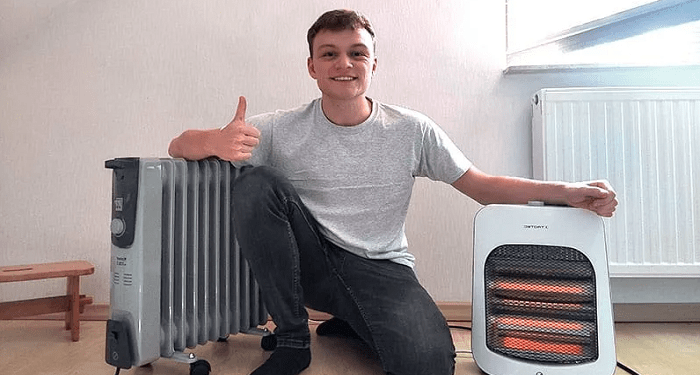One of the most economical ways of autonomous heating for a private cottage is with mains gas and gas boilers. Modern heating equipment, which works on this type of fuel, is reliable, compact, and also able to work under the control of home automation systems, which are responsible for comfort in the house.
What should be taken into account when designing?
Of course, it is desirable to decide on the choice of heating equipment at the stage of the architectural design of the cottage. The location of the boiler (boiler room), the route of laying pipelines, the location of heating devices in the rooms should be indicated in the relevant sections of the work project.
As the latter, traditional radiators are most often used, placing them under the windows. The distribution system of pipes through which the coolant circulates can be one-pipe or two-pipe. One pipe is less material-intensive and to a certain extent independent – it can work without an additional circulation pump. Its peculiarity is that the coolant passes through all the radiators in sequence, and in a spacious house with many radiators, it may turn out that in the rooms located directly at the exit from the boiler room, they are hot, and in distant rooms – barely warm. Two-pipe wiring allows you to achieve a more even distribution of heat, but for a compact house, it may turn out to be an unnecessarily expensive solution.
Having chosen the “warm floor” system, it is important to keep in mind that not all boilers work correctly with this type of heating. Recently, the so-called plinth systems are also gaining popularity, when the same compact radiators are located in massive plinths around the perimeter of the premises.
What kind of boiler do you need?
The general rule that determines the choice of a boiler for regions of the middle band is 1-1.2 kW of power (denoted as the nominal thermal power) per 10 m² of heating area. In the northern regions – 1.5-2 kW. But these are only approximate ratios, then the nuances begin. Professionals who perform heat engineering calculations will have to take into account many factors: the height of the room, the materials of the enclosing structures, the size of the windows, the orientation of the building in the directions of the world, the real performance of the equipment, the mode of operation, etc.
Thus, to maintain a comfortable temperature in a house up to 120 m², in any case, a wall-mounted boiler with a nominal capacity of at least 12 kW will be required, and accordingly, for a cottage with an area of 250 m² – 25 kW.
Cascade connection of boilers
In some cases, when it is intended to heat large volumes or, for example, to maintain a positive temperature in non-residential premises (winter gardens, greenhouses, garages), an alternative to a powerful boiler can be the so-called cascade parallel connection (similar to elements in a battery) of two or more boilers of smaller power With this option, two compact condensing boilers in a private house can become an alternative to a bulky boiler room with a floor boiler. The advantages of such a system are wider options for managing the home climate, and economy and increased reliability: sacramento water heaters can work together and alternately, giving each other the opportunity for preventive maintenance and rest.
But for the cascade system to fully realize its effectiveness, it must be designed, installed and configured by professionals.
Not only heating, but also hot water
If it is assumed that the boiler will not only provide heating, but also heat water for domestic needs, it should be double-circuit. The choice of a constructive solution depends on the expected performance of the heating system and the volume of water consumption.
A compact wall-mounted double-circuit boiler is a two-in-one product that performs both tasks for a small private house, a section of a townhouse or an apartment. In more productive systems, built-in boilers or additional equipment for indirect heating in the form of a remote storage boiler are used.
What is a condensing boiler?
The most modern and economical type of gas heating equipment is condensing boilers. Their fundamental structural difference is that they use for additional heating of the coolant the energy that in a regular cauldron literally and figuratively flies out into the chimney.
Operation of a condensing boiler during the heating season allows you to save up to 40% of the energy carrier (gas). And this is important when the homeowner, waiting for a gas main to be brought to his house, heats his possessions with gas in cylinders. In addition, the relatively low temperature of the combustion products in comparison with ordinary boilers allows you to save money during installation: instead of a bulky chimney, an acid-resistant outlet pipe made of stainless steel or plastic can be used here.
Where to place the boiler?
The requirements for placing gas boilers are regulated by the relevant SNiPs. In the general case, the room in which the boiler with a nominal power of less than 30 kW is located must be at least 7.5 m, height – at least 2.2 m and be separated from neighboring rooms by capital walls. Moreover, in a wooden house, the wall on which the boiler is installed must be plastered and covered with a heat-reflecting screen made of non-combustible material. In addition, such a room should have supply and exhaust ventilation, as well as natural lighting at the rate of at least 0.03 m² of glazing per 1 m³ of volume.
Is it possible to place a heating boiler in a kitchen or a spacious bathroom? Of course, but only if this room meets all the above requirements, including the presence of a window.
In addition, the designers will have to take care of uninterrupted power supply to the boiler room, as well as to ensure that service representatives have prompt access to the equipment. Thus, if we are talking about a cottage village, where the owners of the houses leave them in autonomous swimming in the winter under the care of representatives of the management company, the option of locating the boiler in the kitchen is not the best solution.
How to save gas?
First, as already mentioned, the use of condensing boilers minimizes heat leakage into the chimney. Secondly, heating the atmosphere through ventilation systems and enclosing structures is also unwise. The latter must be insulated by the current norms of thermal protection of buildings (SNiP 23-02-2003).
The third savings reserve is to maintain a comfortable heating mode only in those rooms that are currently in use. All others should be set to a regular mode, and it should be extended to the entire house when there is no one in it. For these purposes, the possibility of separate regulation of heat supply to the room should be provided.
Modern control automation modules for heating equipment allow you to set modes using a timer or, in a remote version, via Internet channels. However, the installation of such systems and setting up their correct interaction with “smart home” systems is a topic for a separate conversation.














